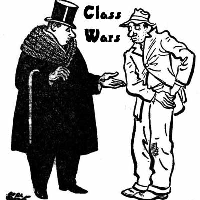California Low-Wage Earners’ Reward for Higher Productivity—Less Money

California wage earners of the non-supervisory sort are 89% more productive than they were 25 years ago, but their real wages have increased just 3%.
Those are about the most positive numbers about worker compensation contained in a new report (pdf) from UC Berkeley researchers, which delivers worse news the further down the economic scale one travels.
“Low-Wage California: 2014 Chartbook” calculated that real wages, after inflation is taken into account, declined 6% for the lowest 10th percentile of wage earners between 1979 and 2014. It was worse for the lowest 20th percentile, -12%, and the lowest 30th percentile, 10%.
That compares unfavorably to the 95th percentile of wage earners, who earned 47% more and the 90th percentile who improved 35%. The 80th percentile was up 17% by 2014, and the 70th percentile, 6%.
“We are seeing the hollowing out of middle-wage jobs over time,” study co-author Annette Bernhardt told the Los Angeles Times.
For purposes of the report, a low-wage earner was defined as making “less than two-thirds of the median hourly wage for full-time workers.” The widely-used metric indicated a median California wage rate of $20.44 an hour in 2014 and a “low-wage” topping out at $13.63.
One-third of Californians are low-wage earners, up from 30% in 2000. The study sampled Californians between the age of 18 and 64, who were not self-employed. Their median wage is $9.97, about half that of all workers ($18.36). That translates in to $15,300 a year. That doesn’t go far in California’s big cities.
Needless to say, low-wage earners also receive fewer paid job benefits, including healthcare, pension and sick days, while being subjected to unpredictable and “on call” work schedules, and wage theft.
Low-income earners are older and have more education than their 1979 counterparts. Ten percent of low-wage earners in 2014 had college bachelor’s degrees and 3% had advanced degrees, compared to a total of 8% in 1979.
Those with some college increased from 31% to 35% since 1979 and high school grads were up one point from 32%. Those with less than a high school education declined from 29% to 20%.
Low-wage earners have gotten older and, presumably, more experienced. The group 35-64 years old increased from 32% in 1979 to 44% now, while their youngest counterparts, 18-19, declined from 16% to 5%.
Most low-wage earners, 56%, are Latino, compared to 39% of the state’s total workforce. Twenty-six percent are white, 11% are Asian and 6% are black.
Low-wage earners are just a step from destitution and their growing numbers portend an incendiary future in congested urban areas, like Baltimore, if not addressed. “It would not be wise to hope that California is going to magically outgrow its low-wage jobs problem in the next 20 years,” researcher Bernhardt said.
–Ken Broder
To Learn More:
California's Low-Wage Workers Earn Less Than in 1979, Study Shows (by Chris Kirkham, Los Angeles Times)
Low-Wage California: 2014 Chartbook (by Annette Bernhardt, Ian Perry and Lindsay Cattell, UC Berkeley)
Ripped off Low-Paid Workers Are Also Cheated out of Legal Judgments (by Ken Broder, AllGov California)
- Top Stories
- Controversies
- Where is the Money Going?
- California and the Nation
- Appointments and Resignations
- Unusual News
- Latest News
- California Forbids U.S. Immigration Agents from Pretending to be Police
- California Lawmakers Urged to Strip “Self-Dealing” Tax Board of Its Duties
- Big Oil’s Grip on California
- Santa Cruz Police See Homeland Security Betrayal in Use of Gang Roundup as Cover for Immigration Raid
- Oil Companies Face Deadline to Stop Polluting California Groundwater





